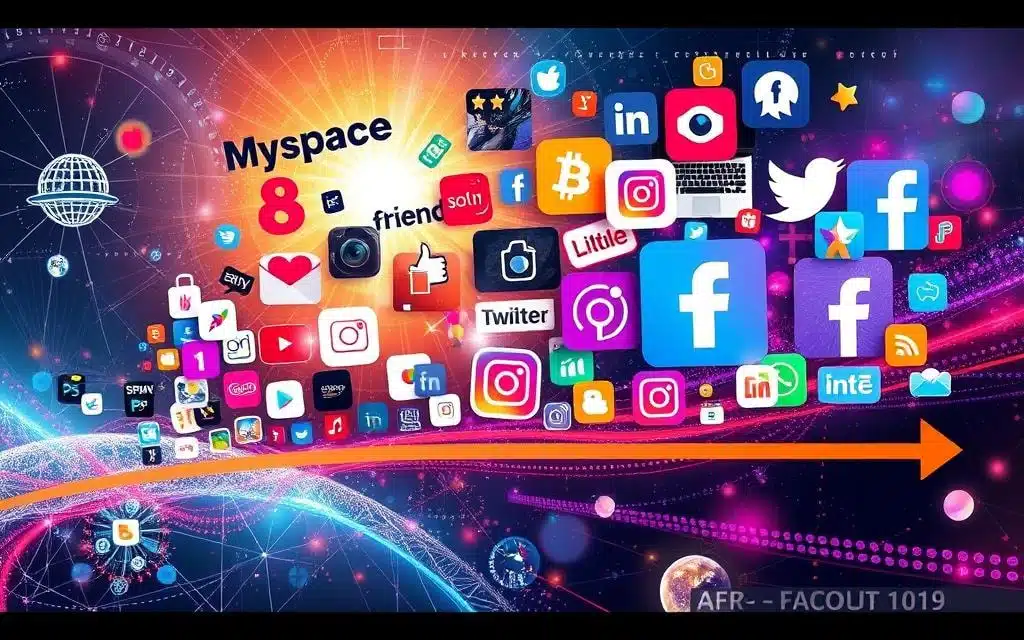The power of Digital Transformation in social media can’t be ignored in today’s tech-driven world. With 3.2 billion users and $173 billion in ad revenue, it’s a game-changer. Businesses must adapt to stay competitive in this digital landscape.
Digital transformation in social media is crucial for success. It helps companies connect with their audience and drive growth. By integrating strategies and technologies through digital transformation initiatives, businesses can enhance customer engagement and streamline operations. By embracing social media marketing, businesses can tap into a vast potential. A comprehensive social media strategy is essential for achieving effective social media campaigns.
The numbers are compelling. 78% of consumers rely on positive social media experiences. User-generated content influences 79% of people’s decisions. These stats show social media’s impact on consumer behavior.
Businesses risk falling behind if they don’t adapt. Social platforms offer unique chances to engage customers. They also provide valuable insights and help build brand loyalty.
Harvard Business Review reports 72% of consumers engage with brands on social media. This leads to stronger brand loyalty. Shopify’s 2020 data shows a 76% increase in social media sales.
Key Takeaways
Digital transformation in social media is essential for businesses to remain competitive in today’s market
Social media platforms offer unparalleled access to potential customers and enable personalized interactions
Consumer behavior and purchasing decisions are heavily influenced by social media experiences and user-generated content
Businesses can leverage social media to drive growth, build brand loyalty, and gather valuable customer insights
Failure to embrace digital transformation in social media can result in falling behind in an increasingly digital-first world
Understanding Digital Transformation in Social Media
Businesses must adapt to the digital landscape to stay competitive. Digital transformation in social media integrates new technologies into a company’s strategy. Conducting market research is crucial in understanding customer needs and competitor strategies. This approach helps businesses engage their audience and achieve better results.
Social media platforms offer vast opportunities for businesses. Facebook has 2.8 billion monthly active users, while Instagram has over 1 billion. Companies can use digital marketing strategies to create targeted content. Monitoring metrics and KPIs while staying updated with social media trends helps identify areas for improvement and implement effective campaigns. This personalized approach drives engagement and connects with diverse audiences.
Key Components of Transformation
To succeed in digital transformation, businesses must focus on key areas. These include adopting new platforms and using AI for data-driven decisions. Implementing cloud computing and automation is also crucial.
Adopting new platforms and technologies
Leveraging AI and analytics for data-driven decision making
Implementing digital processes such as cloud computing and automation
Developing a clear vision and strategy for transformation
Engaging employees and building a digital-first culture
Investing in these areas helps companies streamline operations. It enhances customer experiences and boosts competitiveness. Companies that embrace digital transformation adapt faster to new technologies and market demands.
Industry | Digital Transformation Benefit |
|---|---|
Retail | Online selling platforms, personalized customer experiences, and enhanced inventory management systems |
Banking | Convenient online and mobile banking services, reducing the need for in-person transactions |
Healthcare | EHR systems and telemedicine for virtual visits and online appointments |
Digital transformation offers many benefits, but success isn’t guaranteed. A Bain & Company study shows only 8% of companies achieve their goals. Careful planning and constant strategy adjustments are necessary for success.
Digital transformation is not just about technology; it’s about using technology to achieve business goals and create value for customers.
Digital transformation in social media empowers businesses. It allows them to use social media analytics and data-driven content creation. These tools help deliver great customer experiences and boost brand visibility.
The Evolution of Social Media Platforms
Social media platforms have changed a lot in the last 20 years. They started as simple networking tools. Now, they’re powerful broadcasting and marketing platforms. Our interactions with social media content have also evolved.
How Platforms Have Changed Over Time
Early social media focused on connecting people and building communities. Platforms like Six Degrees and MySpace were pioneers. These platforms grew and became broadcasting powerhouses. Users could now reach large audiences instantly.
Establishing a presence on various social media platforms is crucial for analyzing and evaluating the effectiveness of social media campaigns. Social media is now a main news source and brand promotion tool. Algorithms prioritize content based on engagement. This pushes creators to make high-quality, engaging content. User-generated content and influencer collaborations have become popular.
Platform | Launch Year | Key Milestones |
|---|---|---|
Six Degrees | 1997 | First known social media platform |
2004 | Reached 50 million users by October 2006 | |
2006 | Introduced promoted tweets in 2010 | |
2003 | Began offering sponsored content in 2013 | |
2010 | Started offering sponsored posts in 2015 |
Impact of Technology on User Engagement
Tech advances have made social media more accessible and interactive. Mobile devices and high-speed internet play a big role. Platforms now offer features like stories and live streaming. They’ve also added e-commerce integration to boost omnichannel integration.
The power of social media to amplify messages and reach broader audiences remains unparalleled.
Social media keeps changing, and businesses must adapt. They need to balance broad reach with meaningful engagement. By using the power of social media, brands can build lasting relationships. This helps them stay competitive in the digital world.
Reasons for Transformation in Today’s Market
Digital transformation in social media is crucial for brands to stay competitive. The business landscape is evolving rapidly. Companies must embrace change to thrive in the digital age.
Increased Competition Among Brands
The online space is crowded with businesses vying for audience attention. 30% of companies struggle with digital transformation, highlighting the need for innovative strategies.
Brands risk falling behind if they don’t keep up with change. The growing number of patents for new technologies shows this trend.
Starbucks, Amazon, and Uber showcase the power of digital transformation. They’ve enhanced customer experiences and improved efficiency. These companies inspire others by gaining a significant competitive advantage.
Changing Consumer Behavior
The COVID-19 pandemic has accelerated shifts in consumer behavior. More people now turn to online platforms for daily needs. Selecting the right social media accounts and platforms is crucial to enhance engagement and maximize value for business goals.
McKinsey data reveals permanent changes in consumer habits. Three out of four Americans tried new shopping behaviors during the pandemic.
Consumer Expectation | Percentage |
|---|---|
Willing to spend more for a customized experience | 61% |
Influenced by personalized experiences when shopping | 82% |
Consumers seek personalized interactions with brands on social media. Businesses must adapt their strategies to meet these expectations.
Social selling is now crucial for digital transformation. It helps brands engage with their target audience and build lasting relationships.
Marketers use data analytics and AI to gain insights into customer preferences. This helps tailor campaigns, driving online community engagement and fostering brand loyalty.
Benefits of Digital Transformation for Businesses
Businesses gain a competitive edge by embracing digital transformation in social media marketing. Social media offers significant advantages over traditional marketing methods, extending a company’s reach and providing personalized customer interactions. Data-driven content creation and effective digital strategies drive growth and success. Companies can reap numerous benefits through these approaches.
Enhanced customer interaction is a key advantage of digital transformation. With 5.04 billion active social media users worldwide, businesses have unprecedented engagement opportunities. Personalized content and responsive communication build trust and foster long-lasting customer relationships.
Improved Data Analytics
Digital transformation empowers businesses with improved data analytics. Facebook’s 3.05 billion monthly active users provide valuable insights into customer preferences. These data-driven insights inform content creation and marketing strategies.
Companies can tailor their efforts to resonate with target audiences. This approach ensures that marketing campaigns are more effective and efficient.
Platform | Monthly Active Users | Daily Active Users |
|---|---|---|
3.05 billion | – | |
– | 500 million | |
421 million | – |
Greater Brand Visibility
Digital transformation significantly boosts brand visibility. Instagram’s 500 million daily users offer a powerful visual storytelling medium. Twitter’s 421 million monthly users make it ideal for real-time conversations.
Businesses can expand their reach through targeted advertising and influencer partnerships. These strategies help attract new customers and increase brand awareness.
Digital processes reduce human errors by eliminating time-consuming manual data entry.
Social commerce is on the rise, integrating e-commerce on social media platforms. This streamlines the buying journey for customers. It opens up new avenues for growth and revenue generation.
Embracing digital transformation is crucial for businesses to thrive today. A 2017 McKinsey survey found only 8% of businesses could survive without digitizing. Companies like Blockbuster and Kodak show the risks of resisting change.
Tools and Technologies Driving Transformation
Cutting-edge tools and technologies are propelling digital transformation in social media. Businesses are leveraging these innovations to stay competitive. Let’s explore some key drivers of this transformation.
AI & Machine Learning Applications
AI and Machine Learning are revolutionizing social media approaches. These technologies enable automated, personalized content creation at scale. AI-powered chatbots provide instant, 24/7 customer support efficiently.
Machine learning algorithms drive predictive analytics for precise audience targeting. This optimizes ad spend and maximizes ROI. Organizations using AI and ML are three times more efficient than others.
However, 70% of digital transformation efforts fail. This highlights the need for strategic planning and execution.
Social Media Management Tools
Managing multiple social media platforms can be challenging. Tools like Hootsuite and Sprout Social streamline this process. They offer a hub for scheduling content, monitoring mentions, and analyzing performance.
Social media analytics provide insights into audience behavior and preferences. This allows for data-driven decision-making in social media strategies.
Tool | Key Features | Pricing |
|---|---|---|
Hootsuite | Content scheduling, analytics, team collaboration | Starting at $49/month |
Sprout Social | Social listening, reporting, customer care | Starting at $99/month |
Buffer | Content publishing, analytics, team management | Starting at $15/month |
User-generated content (UGC) is a powerful asset in digital transformation. It fosters trust, credibility, and engagement by showcasing authentic customer content.
Omnichannel integration ensures a seamless customer experience across all touchpoints. This includes social media, websites, and other platforms.
The key to successful digital transformation is not just about adopting new technologies, but also about fostering a culture of innovation and agility.
Businesses must embrace these tools to thrive in the digital age. AI, ML, and social media platforms are crucial for success.
Companies can deliver exceptional experiences by using UGC and omnichannel integration. This approach helps them stay ahead in the evolving social media landscape.
Strategies for Implementing Digital Transformation
Digital transformation in social media needs a strategic approach aligned with business goals. Companies can overcome challenges by developing a clear vision and engaging employees. Success leads to increased engagement and revenue growth.
Developing a Clear Vision
Start by creating a vision that matches your business objectives. This may include updating your brand’s voice and visuals for social media. A PwC study shows 45% of executives expect revenue growth within 5 years of digital transformation.
Engaging Employees in the Process
Employee engagement is key for smooth adoption of new technologies and processes. However, risk-averse cultures can hinder progress. A 2016 Progress study found 47% of executives see this as a major obstacle.
To tackle this issue, companies can take several steps. Provide training and support to employees. Encourage teamwork and knowledge sharing. Celebrate wins and learn from setbacks.
Monitoring and Adjusting Strategies
Regularly track performance and adjust strategies using data-driven insights. Tools like Google Analytics and Sprout Social offer valuable audience and engagement data. This information helps companies make smart decisions.
Data analytics brings significant benefits to companies. Here are some examples:
Company | Digital Transformation Strategy | Results |
|---|---|---|
Sephora | AI-driven personalization and automated customer service | Increased user engagement and sales |
Domino’s Pizza | AI and automation for enhanced customer experience | Customers can order pizza through various digital channels, including social media |
Coca-Cola | Data analytics for targeted marketing campaigns | Increased alignment with consumer preferences |
Tools like HubSpot and Buffer help streamline digital transformation efforts. They maximize the impact of influencer collaborations through marketing automation and social selling.
Case Studies of Successful Digital Transformation
Digital transformation is vital for social media marketing strategies. It helps businesses enhance customer engagement and drive growth. Social media marketing case studies offer valuable insights into leveraging technology effectively.
Netflix is a prime example of successful digital transformation. They added 36 million new subscribers after the COVID-19 pandemic started. Their success stems from technology-driven content creation and data analysis.
Brands That Got It Right
Amazon Business has tapped into the B2B wholesale market worth trillions. They’ve become a major player by using their digital platform effectively.
Tesla delivered 936,172 vehicles in 2021, up 87% from 2020. Their focus on digital innovation and electric vehicle tech has propelled them forward.
DBS Bank’s digital initiatives have attracted millions of new customers. They’ve engaged younger users through online community efforts and seamless digital experiences.
Lessons Learned from Failures
Some brands have faced challenges in the digital realm. Insensitive content and slow responses to customer concerns have caused backlash.
These experiences highlight the importance of authenticity and responsiveness. Aligning content with brand values is crucial in the digital space.
Digital transformation is not just about technology; it’s about using technology to achieve business goals and create value for customers.
Studying successes and failures helps businesses adapt their digital marketing strategies. Investing in the right tools is key to success.
Fostering a digital-first culture is essential. Continuous monitoring and adjusting of strategies help navigate the ever-changing digital landscape.
Challenges in the Digital Transformation Journey
Digital transformation in social media offers many benefits. However, organizations often face hurdles along the way. These challenges can hinder successful implementation of data-driven content creation and analytics initiatives.
Cultural resistance is a major obstacle. Studies show 70% of digital transformations fail due to employee resistance. This often stems from fear of the unknown or job insecurity.
To overcome this, organizations must align employees with the digital vision. They should foster a culture that embraces change. This helps employees feel more comfortable with new technologies.
Talent Shortages and Skill Gaps
Skilled professionals in emerging technologies are in short supply. The demand for digital skills often surpasses the available talent pool. This leads to a widening skill gap in many organizations.
To bridge this gap, companies must invest in continuous training. They should also consider flexible workforce models. This allows them to access digital expertise more easily.
Challenge | Percentage of Organizations Affected |
|---|---|
Lack of technically skilled employees | 54% |
Cultural resistance to change | 70% |
Legacy systems integration | 65% |
Data security and privacy concerns | 58% |
Budget Constraints and ROI
Budget constraints make it hard to fund necessary tools and initiatives. Organizations must balance investments with demonstrating return on investment (ROI). Establishing key performance indicators is crucial.
Implementing monitoring mechanisms for ongoing ROI assessment is also important. This helps justify the costs of digital transformation projects.
“Digital transformation is not just about technology; it’s about people, processes, and culture. Organizations that fail to address these challenges risk being left behind in the digital era.”
To succeed, organizations need a clear digital transformation strategy. They should engage employees and continuously monitor their approaches. Addressing resistance, bridging skill gaps, and managing costs are key.
By tackling these challenges, businesses can unlock digital transformation’s full potential. This leads to improved social media strategies and overall success.
The Role of Leadership in Transformation
Leadership drives successful digital transformation in social media. It’s key for social selling and omnichannel integration. Executive buy-in and a digital-first culture are vital.
Michael Schrage from MIT Sloan believes in constant learning for CEOs. This helps them use AI, automation, AR, VR, blockchain, and cryptocurrency effectively.
Benjamin Pring from Cognizant sees digital transformation as a top priority. Many organizations focus on this in 2022.
Importance of Executive Buy-In
Executive buy-in is crucial for resource allocation and initiative prioritization. David Kiron from MIT Sloan Management Review leads the Big Ideas program.
He emphasizes the need for a clear strategy in digital transformation.
“The digital transformation success rate is a crucial challenge for leaders.” – David Kiron, MIT Sloan Management Review
Building a Digital-First Culture
A digital-first culture promotes innovation, agility, and data-driven decisions. Desmond Dickerson from Cognizant consults on digital strategies for user experience.
He outlines four steps for digital transformation success:
Communicating the vision clearly
Assessing current digital maturity
Conducting customer journey mapping workshops
Executing roadmap initiatives based on business priorities and customer experience impact
Leader | Organization | Contribution |
|---|---|---|
Michael Schrage | MIT Sloan School of Management | Research on digital media’s impact on innovation |
Benjamin Pring | Cognizant’s Center for the Future of Work | Insights on how new technologies shape the future of work |
David Kiron | MIT Sloan Management Review | Examination of macrotrends in management |
Desmond Dickerson | Cognizant | Consulting on digital strategies prioritizing user experience |
These principles and expert insights guide successful digital transformation. They help organizations navigate social media complexities. This unlocks growth opportunities and boosts customer engagement.
Future Trends in Digital Social Media Transformation
Social media is evolving rapidly, with exciting trends shaping its future. Currently, over 5 billion people use social media worldwide. Experts predict this number will grow to 6 billion by 2028.
User-generated content is on the rise, with 50 million content creators globally. Brands are turning to their audiences for authentic, engaging content. Instagram’s ‘Born on Instagram’ initiative encourages Gen Z to become creators and monetize content.
Influencer collaborations are becoming increasingly important. The value of global influencer marketing has tripled since 2019. Micro-influencers with niche audiences are popular for brand partnerships.
Brands focus on building long-term relationships with influencers. This trend will lead to more innovative and impactful influencer collaborations in the future.
Predictions for the Next Five Years
The next five years will bring key developments in social media marketing:
Personalization and hyper-targeting will become more sophisticated. AI and machine learning will drive this trend. One-third of brands already invest in generative AI for personalization.
Video content will continue to dominate. In 2022, 65% of all internet traffic came from video. Brands must create engaging, high-quality video content to capture audience attention.
Influencer collaborations will become more strategic and long-term. Brands will build partnerships with creators who align with their values and target audiences.
Emerging Technologies to Watch
Several technologies are set to revolutionize social media marketing:
Artificial Intelligence (AI): The global AI market in social media will reach $3.71 billion by 2026. AI will help brands understand customer behavior and create personalized experiences.
Voice search and virtual/augmented reality: These technologies will create new opportunities for immersive, engaging content experiences.
Blockchain: This technology can revolutionize social media marketing and influencer collaborations. It enables transparent, secure transactions and ensures authentic user-generated content.
“The future of social media is about creating authentic, personalized experiences for users. Brands that embrace emerging technologies and collaborate with creators to produce engaging, user-centric content will be the ones that thrive in the years to come.”
The future of digital transformation in social media is full of possibilities. Brands can build deeper connections with their audiences by staying aware of trends and technologies.
Measuring Success in Digital Transformation
Measuring digital transformation success is vital for businesses. Key performance indicators (KPIs) and return on investment (ROI) provide valuable insights. These metrics help companies make data-driven decisions to improve their social media strategies.
Key Performance Indicators (KPIs)
Several essential KPIs help assess digital transformation in social media. These metrics show how well strategies connect with target audiences. They also reveal if desired outcomes are being achieved.
Important KPIs to track include:
Engagement rates (likes, comments, shares)
Follower growth
Website traffic generated from social media
Lead generation
Conversion rates
Regular KPI monitoring helps identify areas for improvement. It allows businesses to adjust their digital marketing strategies as needed. Low engagement rates may signal the need to change content or posting times.
Tools for Measuring ROI
Calculating social media ROI requires robust analytics tools. These tools track costs like ad spend and labor. They then compare these costs to generated revenue or value.
Popular ROI measurement tools include:
Tool | Description |
|---|---|
Google Analytics | Tracks website traffic, user behavior, and conversions originating from social media |
Platform Insights | Native analytics provided by social media platforms (e.g., Facebook Insights, Twitter Analytics) |
Third-Party Analytics Software | Comprehensive tools that aggregate data from multiple sources and provide advanced reporting capabilities |
These tools help businesses understand their social media efforts’ financial impact. They enable informed decisions about resource allocation and future investments. Social media analytics optimize digital transformation strategies and ensure tangible results.
“Without data, you’re just another person with an opinion.” – W. Edwards Deming
Digital transformation success in social media depends on data-driven content creation. Continuous performance monitoring is also crucial. Businesses can maximize their social media impact by focusing on key metrics.
Conclusion: Embracing the Change
Digital transformation in social media requires businesses to adapt quickly. Companies must stay competitive by using new technologies and meeting customer needs. AI, data analytics, and social media management platforms can boost online engagement and drive sales.
These tools also help achieve seamless omnichannel integration. Businesses can enhance their online presence and connect with customers across platforms.
Call to Action for Businesses
To succeed, businesses need a clear strategy aligned with their goals. This means investing in talent, technology, and processes that support digital transformation.
Companies should foster innovation and continuous learning. This empowers employees to adapt to new challenges and find growth opportunities.
Prioritizing customer-centricity and using data-driven insights is crucial. These practices help deliver personalized experiences that resonate with audiences.
Final Thoughts on the Future of Social Media
Social media’s future will evolve rapidly. Decentralized platforms like Mastodon and Peepeth are gaining popularity. Blockchain technology is increasing privacy, security, and user control. AI and machine learning will automate processes and personalize content.
Businesses must stay informed about these trends. Adapting to changes will help companies grow and succeed in the digital landscape.
FAQ
What is digital transformation in social media?
Digital transformation in social media integrates new technologies into a company’s strategy. It uses AI, analytics, and digital processes to improve customer experiences. This approach enhances corporate operations and adapts to changing market needs.
Why is digital transformation in social media important for businesses?
It helps businesses stay competitive in today’s fast-paced market. Companies can meet customer expectations and enhance interactions. Digital transformation provides valuable insights through data analytics and increases brand visibility.
What are some key components of digital transformation in social media?
Key components include adopting new platforms and using AI applications. Social media management tools are crucial for effective strategies. Data-driven content creation and integrating social media with other marketing channels are also important.
How have social media platforms evolved over time?
Social media platforms now offer features like stories, live streaming, and e-commerce integration. Mobile devices and high-speed internet have made social media more accessible. These changes impact how businesses use platforms for marketing and customer service.
What are the benefits of digital transformation in social media for businesses?
Benefits include enhanced customer interaction through personalized content. Improved data analytics provide insights into customer preferences. Digital transformation also increases brand visibility through targeted advertising and influencer partnerships.
What tools and technologies are driving digital transformation in social media?
AI and machine learning enable automated content creation and chatbots for customer service. Predictive analytics help with targeted advertising. Management tools like Hootsuite streamline content scheduling and reporting across platforms.
How can businesses implement digital transformation in their social media strategy?
Develop a clear vision aligned with business goals. Engage employees in the process and foster a digital-first culture. Continuously monitor performance and adjust strategies based on data-driven insights.
What challenges do businesses face in their digital transformation journey?
Challenges include resistance to change from employees and stakeholders. Budget constraints can limit investment in necessary tools and talent. Ensuring data privacy and security is crucial.
What role does leadership play in driving successful digital transformation in social media?
Leadership secures executive buy-in and allocates resources for digital initiatives. They communicate the vision and benefits to all stakeholders. Leaders build a culture that fosters innovation and data-driven decision making.
How can businesses measure the success of their digital transformation efforts in social media?
Key performance indicators include engagement rates, follower growth, and website traffic. Lead generation and conversion rates are also important metrics. Tools like Google Analytics help track and analyze these metrics.

















